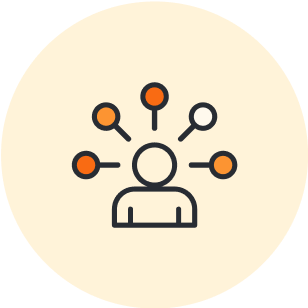In America’s work-obsessed culture, employee burnout is often considered par for the course. Eating over our desks at lunch, staying late into the evening, and forgoing vacations for fear of getting hopelessly behind with work—it all takes a toll.
In fact, a 2023 Aflac study reveals that 57% of U.S. workers report feeling at least moderately burned out on the job. Employees dealing with burnout are 63% more likely to take a sick day and 2.6 times more likely to be actively seeking a different job, according to Gallup. And leaders around the globe are concerned, rating employee burnout as a top business risk in 2024.
Fortunately, there are methods for dealing with this phenomenon. In this article, we’ll explore what causes employee burnout, proven strategies for preventing burnout in the workplace, as well as best practices you can use to maintain growth, increase productivity, and meet changing employee needs.
Signs of employee burnout
Preventing employee burnout means you first have to know what burnout looks like. Since a lot of burnout symptoms are internal (e.g., feelings of inadequacy, gloominess, or lack of motivation), employee burnout can sometimes be tough to spot before it’s too late. That’s why it’s not only important to track employee performance but to get to know your employees well and touch base with them often so you can identify and address concerns early.
Here’s a few signs of employee burnout to be on the lookout for:
- Fatigue
- Lack of satisfaction with work
- Low energy
- Lack of focus
- Decreased productivity
- Headaches or stomach issues
- Missed deadlines
- Increased expressions of cynicism
- Impatience or annoyance with coworkers or assignments
How to prevent employee burnout
Use these five strategies to prevent employee burnout and drive engagement, retention, and satisfaction in your workforce.
1. Actively visualize your company's projects
Too much work and/or too little impact can lead to employee burnout. Employees want their work to matter—–and they don’t want to drown under the weight of too much work. Complex or unclear workflows can contribute to these issues. Whether you run a small business or oversee a multinational organization, without any insight into how your teams collaborate or which individuals are assigned to specific tasks, bottlenecks are inevitable. This is why visibility into employee workload is a must.
In the midst of a time-sensitive or mission-critical project, relying on your email threads, personal notes, and whiteboard drawings is often not enough.
For the sake of clarity and accountability, visualize your company’s projects by creating a process flowchart. In this case, using a swimlane diagram is quite effective. Using the metaphor of horizontal lanes in a swimming pool, this is how it works:
- Each employee, group, or department is assigned to their swimlane.
- Each lane has process steps to show connections, communication, or handoffs.
- Process waste, redundancies, and efficiencies are highlighted.
The swimlane diagram also provides a straightforward visual representation of the many responsibilities tied to a process—helping each employee to better understand the roles they play, what they’re accountable for, and where their tasks fit in the project timeline. This not only improves workload allocation and project planning, but shows employees exactly how their work impacts the team and organization as a whole.
To add greater value to your process flowchart, link any relevant work documents within your project timeline. Now team members can track tasks and assignments all from one location.
When everyone is able to quickly visualize and clearly understand their responsibilities within the overall process, work soon seems less burdensome and overwhelming. All of which leads to a positive work environment and helps prevent employee burnout.

Learn all the ins and outs of creating a swimlane diagram in Lucidchart.
Go now2. Compensate your employees fairly
When it comes to preventing burnout, fair and competitive employee compensation is a powerful deterrent. When you manage people, it’s critical to know if your organization is offering a level of compensation that attracts new talent and retains current employees.
Retaining employees is much more cost-effective than constantly recruiting new team members. For instance, one SHRM study suggests that the cost to replace a salaried employee averages between 6 to 9 months of salary to cover recruiting and training expenses. For high-earners and employees in executive-level roles, the cost can be even more—up to twice their salary.
Of course, a fair compensation package goes beyond salary alone. In a competitive job market, highly sought-after candidates consider additional perks. You should consider:
- Providing an attractive health insurance plan
- Bestowing a generous amount of vacation days
- Offering profit sharing or 401(k) contributions
To ensure that you are compensating your employees fairly, compare your salaries and benefits against any current HR data. The Economic Research Institute has a database of compensation info for the U.S., Canada and the E.U.,and CompAnalyst lets you match your pay against market salary rates.
When employees truly feel valued for their time and efforts, not only do lingering feelings of burnout subside, they often become more dedicated and loyal workers. And this outcome benefits everyone.

Use this guide to learn how to conduct a pay equity analysis and ensure you are compensating your employees fairly.
Learn more3. Make it easier for employees to work together
When companies are dealing with workplace burnout across an organization, they often cite a lack of teamwork and mutual trust among their employees as contributing factors.
It’s not that people actively avoid collaboration at work. In fact, most of us are happiest when we find opportunities to engage with coworkers and become part of a cohesive team. We gain a sense of belonging when working together. So, what prevents collaboration?
The following are some of the more common (yet preventable) reasons:
- Lack of access to the right tools to manage time and work effectively
- Lack of understanding of individual employee workloads and deadlines
- Competing goals across the organization that promote siloed operations
Fortunately, there are several tools that you can utilize in the workplace to help employees address their time management and productivity challenges. Ultimately, this can also prevent burnout.
- Slack is an instant-messaging platform that encourages constant interaction, file sharing, and more. It also integrates with project management tools like Trello.
- Trello is an intuitive, flexible project management tool. It’s also an effective to-do app with the ability to collect tasks into lists and access a workload overview.
- Google Docs allows teams to create, edit, and store documents and spreadsheets online. A free, web-based application, it facilitates real-time work collaboration.
Managers can also make better use of their existing CRM software dashboards to help employees track their progress, share new information, and work efficiently as a team.
Emphasizing a culture of transparency can help break down silos between departments and teams. Employees need to understand how each task or project contributes to the success of the business. This will allow them to feel an emotional commitment to their roles.
Feeling like part of a team and connected to the people you work with is a major contributor to overall happiness at work. By mindfully working to foster connections between coworkers, employers go a long way toward combating workplace burnout.
4. Change up where your employees can work
For many employees, the source of workplace burnout is the traditional workplace itself. They may feel limited by cubicles and the requisite 9-to-5 schedule. The time spent commuting to work—averaging 52.2 minutes a roundtrip each day, according to U.S. census data—doesn’t help.
Offering employees the freedom and ability to work remotely is a surprisingly effective solution for overcoming this pervasive source of employee burnout and stress.
A 2023 Future Forum survey revealed that employees who are dissatisfied with their level of flexibility at work are 43% more likely to say they feel burned out at work than those who are satisfied with their level of flexibility. Flexible options impacting rates of burnout and job satisfaction include working from home, paid time off, and schedule changes.
Roughly 18% of U.S. employees (or about 28 million people) now work from home. Providing the option to work remotely not only benefits employees. Employers often see immediate increases in workplace productivity.
5. Give consistent feedback to your employees
When deciding how to overcome burnout at work, giving consistent feedback to each of your employees should be a priority. When it comes to preventing burnout, positive and constructive feedback are equally helpful. Each provides better direction and improves morale.
Everyone enjoys recognition and being valued. By providing consistent feedback to your employees, you can encourage continuous learning. This helps people feel comfortable with receiving a critical appraisal of their work and sharing ideas to improve performance.
And constructive feedback doesn’t have to be negative. When approached correctly, it can be an opportunity to clarify expectations, offer better direction, and show employees how invested you are in helping them achieve success.
In the long run, just how important is consistent feedback? Recent data shows that:
- Employees who receive more frequent feedback are 2x more engaged, 3x less likely to apply or seek other jobs, and 1.4x more likely to stay at your organization.
- 6% of all employees say that they want more feedback about their work.
- 1 in 2 employees want more recognition.
Don’t relegate feedback to the semi-annual employee review cycle. To make an impact on employee burnout at your company, provide helpful feedback on a weekly basis.
Putting it all together
Burnout is a real phenomenon, one that can adversely affect productivity and morale, along with the well-being and health of your employees. By using any of these five strategies for preventing burnout at work, your company will be better equipped to retain your most valuable asset—your employees.

Explore resources to optimize your org and improve processes.
Check it outAbout Lucidchart
Lucidchart, a cloud-based intelligent diagramming application, is a core component of Lucid Software's Visual Collaboration Suite. This intuitive, cloud-based solution empowers teams to collaborate in real-time to build flowcharts, mockups, UML diagrams, customer journey maps, and more. Lucidchart propels teams forward to build the future faster. Lucid is proud to serve top businesses around the world, including customers such as Google, GE, and NBC Universal, and 99% of the Fortune 500. Lucid partners with industry leaders, including Google, Atlassian, and Microsoft. Since its founding, Lucid has received numerous awards for its products, business, and workplace culture. For more information, visit lucidchart.com.
Related articles
How to make your org chart the best resource for employees
Many people use their company org chart to simply find the best employee to answer their questions. Use our handy guide to find out how you can transform your org chart into a comprehensive resource for your employees.
10 templates for HR teams
From onboarding tools to org charts—in this article, we'll share free resources for HR teams to stay organized and better empower individuals within their organization.
Tips for an effective new employee orientation process
New hire orientation is your first opportunity to show how invested your company is in its employees—and it can significantly boost your retention numbers. Learn how to improve your new hire orientation process.
A quick and easy guide for onboarding remote employees
Onboarding is one of the most important processes to make your remote employees feel welcome and ready to work, even outside of a traditional office. See our tips for onboarding remote employees.

